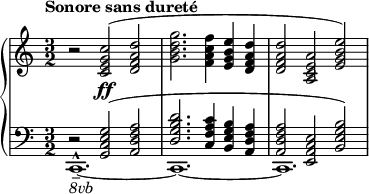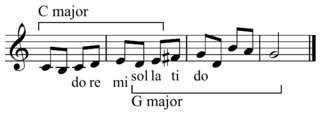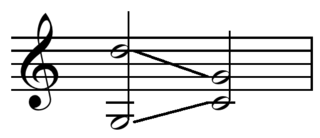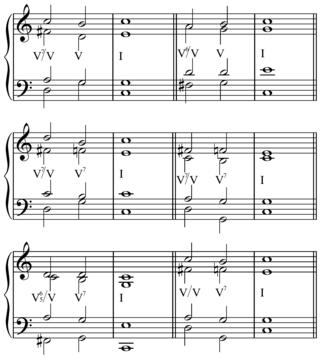Illustrative example
Lines with parallel harmony can be viewed as a series of chords with the same intervallic structure. Parallel means that each note within the chord rises or falls by the same interval.
In music, parallel harmony, also known as harmonic parallelism, harmonic planing or parallel voice leading, is the parallel movement of two or more melodies (see voice leading).
When all voices between chords move in parallel motion, this generally reduces or negates the effect of harmonic progression. However, "occasionally chords such as the tonic and dominant may create the sense of harmonic progression". [1]
Lines with parallel harmony can be viewed as a series of chords with the same intervallic structure. Parallel means that each note within the chord rises or falls by the same interval.



Prominent examples include:
In the Schuman example (Three Score Set for Piano), the inversions of the chords suggest a bichordal effect. [3]
In the example on the top right, we see a series of quartal chords in parallel motion, in which the intervallic relationship between each consecutive chord member, in this case a minor second, is consistent. Each note in the chord falls by one semitone in each step, from F, B♭, and E♭ in the first chord to D, G, and C in the last.
Parallel harmony is frequently used in house music and other electronic music genres. Historically, this resulted from producers sampling chords from soul or jazz and then playing them at different pitches, or using "chord memory" feature from classic polyphonic synthesizers. Modern digital audio workstations offer similar chord-generating tools for achieving parallel harmony. [4]
In music theory, a leading tone is a note or pitch which resolves or "leads" to a note one semitone higher or lower, being a lower and upper leading tone, respectively. Typically, the leading tone refers to the seventh scale degree of a major scale, a major seventh above the tonic. In the movable do solfège system, the leading tone is sung as si.
An altered chord is a chord that replaces one or more notes from the diatonic scale with a neighboring pitch from the chromatic scale. By the broadest definition, any chord with a non-diatonic chord tone is an altered chord. The simplest example of altered chords is the use of borrowed chords, chords borrowed from the parallel key, and the most common is the use of secondary dominants. As Alfred Blatter explains, "An altered chord occurs when one of the standard, functional chords is given another quality by the modification of one or more components of the chord."
In a musical composition, a chord progression or harmonic progression is a succession of chords. Chord progressions are the foundation of harmony in Western musical tradition from the common practice era of Classical music to the 21st century. Chord progressions are the foundation of popular music styles, traditional music, as well as genres such as blues and jazz. In these genres, chord progressions are the defining feature on which melody and rhythm are built.

In music, a chord is a group of three or more notes played simultaneously, typically consisting of a root note, a third, and a fifth. Chords are the building blocks of harmony and form the harmonic foundation of a piece of music. They can be major, minor, diminished, augmented, or extended, depending on the intervals between the notes and their arrangement. Chords provide the harmonic support and coloration that accompany melodies and contribute to the overall sound and mood of a musical composition. For many practical and theoretical purposes, arpeggios and other types of broken chords may also be considered as chords in the right musical context.

In music, modulation is the change from one tonality to another. This may or may not be accompanied by a change in key signature. Modulations articulate or create the structure or form of many pieces, as well as add interest. Treatment of a chord as the tonic for less than a phrase is considered tonicization.
Modulation is the essential part of the art. Without it there is little music, for a piece derives its true beauty not from the large number of fixed modes which it embraces but rather from the subtle fabric of its modulation.
A secondary chord is an analytical label for a specific harmonic device that is prevalent in the tonal idiom of Western music beginning in the common practice period: the use of diatonic functions for tonicization.
In music, texture is how the tempo and the melodic and harmonic materials are combined in a musical composition, determining the overall quality of the sound in a piece. The texture is often described in regard to the density, or thickness, and range, or width, between lowest and highest pitches, in relative terms as well as more specifically distinguished according to the number of voices, or parts, and the relationship between these voices. For example, a thick texture contains many 'layers' of instruments. One of these layers could be a string section or another brass. The thickness also is changed by the amount and the richness of the instruments playing the piece. The thickness varies from light to thick. A piece's texture may be changed by the number and character of parts playing at once, the timbre of the instruments or voices playing these parts and the harmony, tempo, and rhythms used. The types categorized by number and relationship of parts are analyzed and determined through the labeling of primary textural elements: primary melody (PM), secondary melody (SM), parallel supporting melody (PSM), static support (SS), harmonic support (HS), rhythmic support (RS), and harmonic and rhythmic support (HRS).
In Western musical theory, a cadence is the end of a phrase in which the melody or harmony creates a sense of full or partial resolution, especially in music of the 16th century onwards. A harmonic cadence is a progression of two or more chords that concludes a phrase, section, or piece of music. A rhythmic cadence is a characteristic rhythmic pattern that indicates the end of a phrase. A cadence can be labeled "weak" or "strong" depending on the impression of finality it gives.
In music theory, an augmented sixth chord contains the interval of an augmented sixth, usually above its bass tone. This chord has its origins in the Renaissance, was further developed in the Baroque, and became a distinctive part of the musical style of the Classical and Romantic periods.

In music theory, tertian describes any piece, chord, counterpoint etc. constructed from the intervals of thirds. An interval such as that between the notes A and C encompasses 3 semitone intervals and is termed a minor third while one such as that between C and E encompasses 4 semitones and is called a major third. Tertian harmony principally uses chords based on thirds; the term is typically used to contrast with quartal and quintal harmony which uses chords based on fourths or fifths.
In music or music theory, a thirteenth is the note thirteen scale degrees from the root of a chord and also the interval between the root and the thirteenth. The thirteenth is most commonly major or minor.
In music theory, contrapuntal motion is the general movement of two or more melodic lines with respect to each other. In traditional four-part harmony, it is important that lines maintain their independence, an effect which can be achieved by the judicious use of the four types of contrapuntal motion: parallel motion, similar motion, contrary motion, and oblique motion.
Chromaticism is a compositional technique interspersing the primary diatonic pitches and chords with other pitches of the chromatic scale. In simple terms, within each octave, diatonic music uses only seven different notes, rather than the twelve available on a standard piano keyboard. Music is chromatic when it uses more than just these seven notes.
In music theory, a dominant seventh chord, or major minor seventh chord, is a seventh chord composed of a root, major third, perfect fifth, and minor seventh; thus it is a major triad together with a minor seventh. It is often denoted by the letter name of the chord root and a superscript "7". In most cases, dominant seventh chord are built on the fifth degree of the major scale. An example is the dominant seventh chord built on G, written as G7, having pitches G–B–D–F:
A borrowed chord is a chord borrowed from the parallel key. Borrowed chords are typically used as "color chords", providing harmonic variety through contrasting scale forms, which are major scales and the three forms of minor scales. Chords may also be borrowed from other parallel modes besides the major and minor mode, for example D Dorian with D major. The mixing of the major and minor modes developed in the Baroque period.
In music, quartal harmony is the building of harmonic structures built from the intervals of the perfect fourth, the augmented fourth and the diminished fourth. For instance, a three-note quartal chord on C can be built by stacking perfect fourths, C–F–B♭.

In music, consecutive fifths or parallel fifths are progressions in which the interval of a perfect fifth is followed by a different perfect fifth between the same two musical parts : for example, from C to D in one part along with G to A in a higher part. Octave displacement is irrelevant to this aspect of musical grammar; for example, a parallel twelfth is equivalent to a parallel fifth.
In music theory, the half-diminished seventh chord is a seventh chord composed of a root note, together with a minor third, a diminished fifth, and a minor seventh. For example, the half-diminished seventh chord built on B, commonly written as Bm7(♭5), or Bø7, has pitches B-D-F-A:
In music, a sequence is the restatement of a motif or longer melodic passage at a higher or lower pitch in the same voice. It is one of the most common and simple methods of elaborating a melody in eighteenth and nineteenth century classical music. Characteristics of sequences:

In music theory, voicing refers to two closely related concepts: